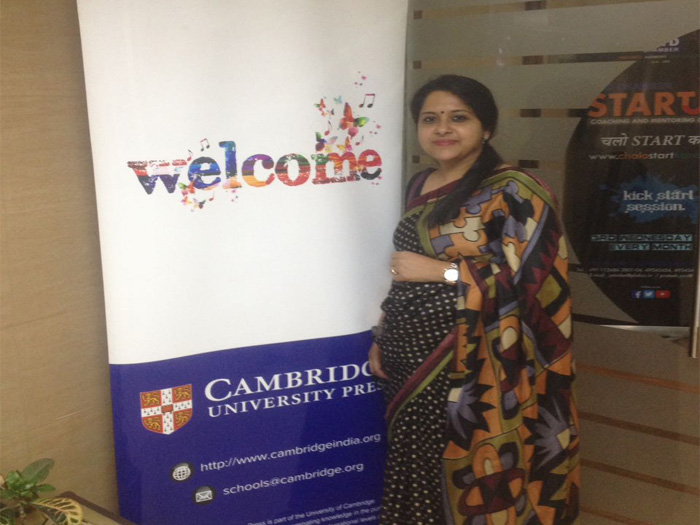Cambridge University Press workshop on effective teaching methodologies for English teachers.
Cambridge University Press organised a workshop for educators on Effective Teaching Methodologies for 21 Century ELL (English Language Learner), on 5th November 2016. The venue of the workshop was the PHD Chamber of Commerce and Industry and the workshop was conducted by Dr. C. L. N. Prakash, Senior ELT (English Language Teaching) Consultant, Cambridge University Press. The objective of the workshop was to offer best teaching and learning solutions to educators. The session was attended by Gandharvi Mukherjee from our School.
Mr. Prakash listed the aims of the workshop, namely, how to make tasks communicative, read effectively, teach literary texts and poetry in a creative way, how to teach grammar creatively and how to integrate all four skills, i.e., listening, speaking, reading and writing into a lesson. He began by telling us that opportunities must be given to students to use the language in the class in the order- Listening, Speaking, Reading and Writing. This would ensure maximum student participation and students will learn the best way- learning by doing.
Keeping his promise of making the session interactive and interesting, Mr. Prakash gave us an interesting activity to do. We were given rubrics for a grammar poem and then were asked to compose a short poem. The rubrics were as follows:
Ist line- article+noun
2nd line- participle+participle
3rd line- adjective,adjective
4th line- repeat line 1
5th line- pronoun+verb
6th line- pronoun+verb
7th line- pronoun+always/never/still+verb
8th line- repeat line 1
9th line- repeat line 3
10th line- repeat line 2

The participants came up with a variety of poems. One such was-
A thought
Provoking, urging
Gentle calm
A thought
It comes
It goes
It never stops
A thought
Gentle calm
Provoking urging.
The above activity would serve two purposes in the class. It is a good way to teach grammar and also the composition of short poems.
Mr. Prakash spoke about reading strategies and asked for opinions on whether they were effective or otherwise.
Using a finger to help the eyes follow lines of the text and reading each word carefully in order to understand the entire text are ineffective ways of reading as they bring down the pace of reading.
Some of the effective reading strategies that were discussed were:
1. Looking at pictures and other visuals before reading.
2. Keeping eyes moving past the unfamiliar words and thus trying to understand the main ideas.
3. Saying words quietly to oneself. This supports the thinking process. Mouthing words interferes with the thinking process while reading.
4. Trying to think about or predict the next part of the text. This incites curiosity among readers.
5. Creating some questions for one-self before reading which one thinks or hopes the text will answer. Mr. Prakash laid stress on elicitation in the class, that is, not explaining but teaching the students to understand by asking questions. This helps them think.
6. Thinking about the structure of the text by identifying the main ideas and supporting ideas.
The next innovative activity was the Homophone Game. This game can be easily played in the class to enhance understanding of the students regarding this grammar topic. The class was divided into two parts. Mr. Prakash gave clues to each group and whichever group had the maximum number of teachers guessing the right answers was declared winner. The teams had to guess the name of the body part on which the clue was based. Sisters daughter is called niece and the body part that is the homophone for it, is knees. Similarly, the ego in oneself is I and the body part that is a homophone for it is eye. It was great fun playing the game as teachers! One can imagine the excitement of students when they get to play it in class!
The next exercise was based on checking the students answers in a kinesthetic manner, in order to ensure maximum participation in the class. The activity was called the Four Corners Activity. Each corner is allotted a name - Fruit, Grocery, Stationery and Vegetables. A list of items was provided and we were asked to distribute each item amongst the categories. Once that was done, the name of each item was announced and the participants had to run to the corner the item belonged. Mr. Prakash suggested that this technique could be applied to any other question in the class as well. The technique would certainly create interest among students.
Last but not the least, was an activity to enhance students understanding of the structure of a story. We were given a handout in which there were two stories jumbled up as one. Our task was to separate the two. It wasn't easy as the two stories looked similar. This was what made the task challenging yet interesting. The activity was a group activity, so we put our heads together and went ahead with the task.
The session ended with the launch of a new series of English textbooks by the Cambridge University Press - Communicative with Cambridge English Course for CBSE.
Ms. Gandharvi Mukherjee.













